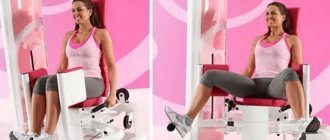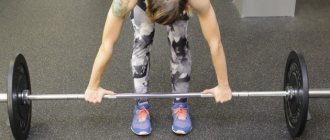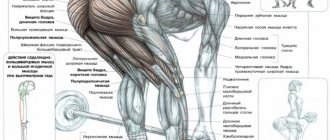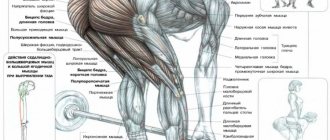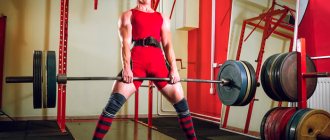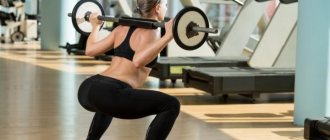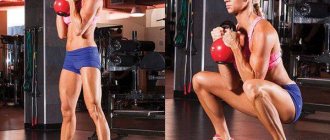Sumo squats are an effective exercise for training the buttocks and adductor surface of the thigh; it will be relevant not only for the fair half of humanity, but also for men, this type of squats is also useful, since with a certain placement of the feet, the load also falls on the quadriceps. The exercise does not involve additional muscles that stabilize the body position, which can be considered an advantage. Squats are performed not only with a barbell, but also with a dumbbell and in a Smith machine. So, what are sumo squats and whether this type of load should be included in the training process, we will find out right now!
Benefits and Disadvantages of Sumo Squats
This exercise is suitable for both men and girls due to its active effect on the muscles of the lower body. When performing sumo squats, those muscles are used that are not used in the classical squat technique. It is also worth noting the following advantages of sumo squats:
- Complex work of the muscles of the legs and buttocks.
- Effective work of the adductor muscles, which is a very relevant activity in women's training.
- Improves hip flexibility and mobility.
- Effectively improves blood circulation in the legs and pelvic organs.
- Ability to work with various weights and sports equipment (barbell, dumbbell, kettlebell, bag and other equipment).
- Sumo squats are suitable for a home exercise routine.
- By reducing the inclination with a dumbbell, the load on the lower back is reduced.
Of course, there are also disadvantages.
- For example, the technique of performing sumo squats is somewhat more complicated than the classic version. In this case, you need to squat widely and carefully ensure that your knees do not bend inward. To do this, you need to use a light weight, at least at first.
- It is also worth noting that sumo squats place a significant load on the knee and hip joints, which, by the way, are in an unusual position throughout the entire range of motion.
Varieties and techniques for performing sumo and plie exercises
First, let's differentiate between sumo and plie squats. Sometimes these concepts mean the same exercise, and yet they have some differences.
Plie squats involve a wide stance with the legs remaining straight while squatting. In this case, it is more convenient to hold the weight (kettlebell or dumbbell) in your hands.
During plie squats, the body remains straight the entire time.
Sumo squats involve wide stance of the legs, and during the exercise the body leans slightly forward, the pelvis is pulled back. In this case, it is quite convenient to hold the barbell on your shoulders.
During sumo squats, the body at the bottom point must be tilted slightly forward to maintain balance.
Both exercises involve the same muscle groups. When choosing between plie and sumo, you should focus on your feelings and anatomical features, as well as the purpose of the exercise. If you work with heavy weights, then it would be logical to give preference to sumo with a barbell on your shoulders. For girls who train with light weights, or for beginners, the option of plie or sumo with dumbbells or kettlebells would be more optimal.
Technique for performing sumo squats with a dumbbell or kettlebell
During wide-legged squats, the kettlebell serves as a good counterweight and helps maintain balance.
This is a great option for a beginner because you can take a very small weight and gradually increase it. There is no fundamental difference between using a dumbbell and a kettlebell. You can hold the projectile either on outstretched arms or near the chest.
- We take the projectile in our hands.
- We place our legs much wider than our shoulders, with our toes turned outward. How wide to place your feet and how far to turn your toes should be determined by your sensations. Here it is worth considering the level of stretching, preparation, anatomical features, height and length of the legs. It is important that the knees do not “fall” inward, but look clearly in the same directions as the socks.
- Keep your back straight, shoulders back, look straight ahead - don't lower your head.
- We take a breath and go down. It is important not to lean forward too much. If you can’t keep your body straight, a slight forward bend is acceptable.
- It is necessary to squat to parallel with the floor or slightly lower, but not much: do not dive all the way to the floor.
- We linger at the bottom point for a few seconds and exhale as we rise to the top.
- At the top point we tense our buttocks.
Technique for performing sumo squats with dumbbells.
The exercise is performed in 3-4 sets of 10-15 times. If the weight is heavy, you can do 5 sets of 6-8 times.
Technique for performing a wide-legged sumo squat with a barbell
If you train with heavy weights, do not forget about 1-2 warm-up sets with an empty bar.
Sumo squats with a barbell differ from classic squats due to their wider stance.
- Remove the bar from the stand. The bar should not lie on the neck, but lower on the back muscles, otherwise there is a risk of injuring the neck.
- We spread our legs wide, with our feet turned toes outward.
- Keep your back stiff and straight. On large scales, be sure to secure the lower back with a special belt.
- Look straight ahead or slightly upward (this will help you rise from the lowest point).
- We inhale and slowly lower ourselves down until parallel to the floor. Watch the position of your knees; they should not “fall” inward.
- With an exhalation we rise and at the top point we tense our buttocks.
Since the weight used for the exercise is quite heavy, it is performed for a small number of repetitions, for example, 8 times for 4 sets or 6 times for 5 sets.
Video: sumo squat technique with a barbell
Video on how to properly do a sumo squat with a barbell:
What muscles work in sumo squats?
The exercise affects the following muscles:
- Adductor muscles of the thigh.
- Quadriceps femoris muscles.
- Large gluteal muscles.
Indirectly and to a lesser extent, the hamstrings are involved, as well as the spinal stabilizer muscles, back muscles, abdominal muscles and calf muscles.
Is it possible to harm the body?
Yes, you can. We already mentioned above that sumo squats require a good stretch and warm-up. If you start squats without warming up, you can provoke microtrauma to muscles, damage to joints, knees, and stretch ligaments and tendons. Be careful, especially with heavy weights. Also, remember the risk of lower back injury.
To minimize harm, work on your technique - if it is correct, you do not risk anything. Sumo squats with a heavy barbell on your own, without a trainer, are recommended only for experienced athletes.
If you have a history of knee or joint problems, be sure to consult with your doctor before starting exercise.
It is forbidden to squat when the body temperature rises, after abdominal surgery, in case of joint injuries, or during pregnancy.
Look on the Internet for photos of the technique of performing sumo squats for girls - you should understand what the correct posture is in a deep squat, as well as in the starting position. Sumo squats are a really cool exercise that helps improve your figure, pump up your buttocks, and improve your physical fitness. Approach any sports activity wisely - study the technique, watch videos, read useful articles. We wish you success in sport!
Sumo squat technique with a barbell
The barbell sumo squat is similar to the dumbbell technique.
- The athlete must remove the barbell from the rack or frame, spread his legs wide and turn his toes 45 degrees to the sides.
- The bar should rest on the trapezius muscles, as with classic squats.
- During the downward movement, inhale, and during the return movement, exhale.
Please note that your knees should be pointing in the same direction as your feet. The pelvis must be moved back.
Performance technique
So, we looked at what muscles work during sumo squats, and also how they differ from classic squats. Now it's time to figure out how to do sumo squats correctly:
- Initial pose – legs are located at a distance 2-2.5 times wider than shoulders;
- The back is straight throughout the entire exercise, the gaze looks forward or slightly upward;
- The toes are turned out synchronously (beginners can place them parallel);
- Slowly lower yourself down as deeply as possible without bending your knees or arching your back. At this time, take a deep breath;
- As you exhale, rise sharply;
- The weight is held at chest level (kettlebell, dumbbell), on the shoulders (barbell, empty bar), in lowered arms;
- Your knees should point in the same direction as your toes (if they are turned out);
- The wider the socks unfold, the higher the load. Ideally, you should learn to turn your feet 90°;
- When you go down, you can move your pelvis slightly back (without bending your back); when you go up, return to the starting position. This will allow you not to carry your knees by your toes, which significantly reduces the load on the joints;
- When you rise, do not straighten your legs completely.
Sumo squats with a kettlebell for girls are a great way to pump up your legs, make your body contours more prominent, and your butt firm and seductive. But this is not the only benefit that exercise has.
Features and technique of sumo squats with a dumbbell
- Take your starting position, standing straight and maintaining a natural arch in your lower back.
- Your legs should be placed wide apart, your feet should be turned to the sides. The width of the legs is determined individually, since each athlete has different flexibility. In any case, they should be positioned wider than shoulder width.
- It is enough to turn your feet at an angle of 45 degrees.
- At the lowest point of the range of motion, the hips should be parallel to the floor.
- The dumbbells need to be lowered with outstretched arms in front of the body, or you can work with one dumbbell, holding it by the weighting disk, which is much more convenient and minimizes the tilt of the body.
Execution technique
Let's take a closer look at each stage of the exercise:
- To begin, you should take a comfortable position and place your feet with your toes outward at a distance greater than or about shoulder width. If during the first approach you experience discomfort due to too much tension, it is better to place your feet closer.
- In most cases, the load is located in front on the arms extended along the body, in the case of a barbell - on the back of the trapezoid with bent arms.
- As you inhale, lower your body with a straight back until your legs are bent at an angle of 90°. It is important to tilt the pelvis as much as possible not forward, but backward.
- Inhaling slowly, without sudden movements, we return to the starting position.
- You need to squat at least five times, preferably 10-15 in several passes. In general, the number of repetitions depends on the physical fitness and goal of the athlete (get the body in good shape, pump up the buttocks, prepare for professional competitions, etc.).
Despite its simplicity, at first it is recommended to perform the sumo deadlift under the supervision of a coach or experienced athlete. And start by using little or no weight to avoid unnecessary strain.
In exercises such as sumo deadlifts, squats and bench presses, 90% of the result depends on the correct technique.
Recommendations
When performing this type of squats, do not go for too much weight . And it’s better to practice the technique with an empty bar or without any weighting. Another very important point is the depth of the squat. With an amplitude in which the thigh falls below parallel with the floor, the gluteal muscles are more loaded, and the load on the knee joints increases.
Sumo squats for girls
Women should include this exercise in their training as the main possible squat. Of course, you don’t need to ignore classic squats, but sumo squats are considered a priority. You can add glute bridges, wide lunges or Bulgarian lunges to your training complex.
Sumo squats for men
Sumo is not as relevant for men, but it can still be used in leg training. Typically, sumo squats are included as the second or third exercise after performing the main load on the quadriceps.
Here's an example of a leg workout using sumo squats:
- Barbell squats with a classic foot position or leg press with a wide foot position.
- Sumo squats with barbell.
- Lunges with dumbbells (walking).
- Leg extension in the simulator.
- Leg bending in the simulator.
- Exercises for the lower leg muscles.
Analysis of the exercise
What muscles work
The wider the stance in a squat, the more the hip adductors, hamstrings and glutes work. But in reality, a lot depends on the length of the back. The longer the back and the more inclined it is, the more the long back muscles are involved in the work.
The quadriceps are still working in the exercise, since there is extension of the lower leg. Therefore, it is completely incorrect to say that this version of the squat completely excludes the quadriceps from the work.
Who is it suitable for?
In this version of the squat, the main working joint is the hip, and it is its condition and functionality that determine the admissibility of a sumo squat. If a person cannot lower himself into a squat with this style because of joint pain, the exercise is not suitable.
Likewise, not everyone is comfortable squatting due to short adductor muscles. This problem is partly smoothed out by stretching, but this does not always work.
It is believed that in sumo you can squat with more weight than in the usual version, but this is only true for those whose pelvic structure allows it. As a rule, people with a narrow pelvis and long legs cannot afford this squat option.
Restricted ankle mobility is not traditionally considered a problem in sumo, but this is not the case. It is not a problem only if mobility in the pelvis and knees is not impaired. But when a person struggles with a sedentary hip, he will most likely fail.
It is worth noting that “treating” heel lifting with a sumo squat in a classic do-squat can only be limited, namely exactly as much as the hip joints and their condition allow this to be done.
Sumo is definitely not suitable for people with a narrow pelvis and tight hip joints. And if this set also includes tall height and a back that is much longer than the hip, you should think about starting to learn the squat from the front, and only then move on to the squat with a barbell on the back, choosing the position individually.
Often “sumo” is called a female squat, adding unnecessary accents to the movement. Namely, pulling the pelvis in a straight position. This only leads to an increase in deflection in the lower back and a strong tilt of the back, but also to probable under-sitting. The lack of proper squat depth, contrary to the opinion of some trainers, removes the load from the buttocks, and does not increase it.
How to Do Sumo Squats
Contraindications
Not recommended for exacerbations of hernias and protrusions. In remission, you can squat with minimal weight. You should not squat if the sciatic nerve is pinched, there are injuries to the joints of the lower extremities in the acute stage, or any problems with the wrists.
Sumo is extremely demanding in terms of stretching and ligament work. If, over time, pain begins to occur in the adductors and in the hip joints themselves, you should abandon the sumo squat for a while and switch to weightlifting squats.
Common mistakes
- Starting the movement with abduction of the pelvis, as in a kettlebell swing or Romanian deadlift, and not with bending at the knees, as in a squat;
- Ambitious weights with poor technique and joint mobility;
- Lowering the head down;
- Too much arch in the lumbar region and head thrown up;
- Lack of rigid fixation of the projectile on the back with hands;
- Knees roll inward when standing up, legs “X”
Error correction
- The first mistake can only be eliminated by acquiring competent technical skill; in other words, you need to start squatting with a classic, comfortable position of your feet, gradually moving them into “sumo” if this technique is necessary;
- The technique can only be developed over time; until it becomes proficient, weights should be used carefully. Contrary to popular belief, you cannot use the Smith machine to practice sumo techniques, because it has a slightly different weight distribution and does not have the most favorable biomechanics;
- Throwing back and lowering the head occurs in response to poor shoulder mobility. You need to work on your shoulder joints and try to increase their mobility. Also, the problem can be solved by stretching the chest, especially if a person is “enslaved” due to his passion for bench press
Recommendations
- There is little point in squatting with a shortened amplitude in sumo if the athlete does not strive to pump up the huge adductors. The buttocks can be activated in a short amplitude only by bending the back. And this means only one thing - you should not squat, but bend over with a barbell, so as not to have problems with over-pumped adductors and underdeveloped rest of the muscle mass;
- The exercise is given to those who have good mobility in the joints. If it is bad, it is developed with simple exercises - machine calf extensions, box squats, goblet squats, Zercher squats and, finally, weightlifting style squats. Only after this - sumo;
- The squat will only improve if you do not only it, but also bending over with a barbell, several available options for deadlifts and hyperextensions;
- A special feature is the need to lower slowly with weight at the start. By the time the knees bend into the corner, the athlete accelerates and stands up - also as quickly as possible.

